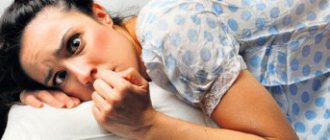Causes of limb tremors
Tremor of the limbs can be physiological or pathological. Physiological tremor is not very pronounced, less noticeable than pathological.
Pathological tremor of the limbs is a symptom of more severe diseases of the nervous system or brain cancer. Among the main causes of tremor are:
Osteochondrosis. Due to pinching of the spinal nerve fibers, circulatory and nutritional disorders occur. Along with tremor, swelling of the face and cardiovascular disorders often appear;
- Alcohol and drug addiction. Taking excessive amounts of alcohol or medications can cause tremors;
- History of trauma. Damage to the nerve roots due to trauma is often reflected in the form of tremors;
- Dysfunction of the central nervous system. The tremor may begin as mild twitching. As the condition worsens, the severity of the symptom increases;
- Psycho-emotional experience. Most often, tremors due to stress occur in infants. This is a variant of the norm if the symptom appears sporadically.
- Excessive mental stress. Worries teenagers or students during exam periods. If severe headache, loss of coordination, aggression or apathy appear along with tremor, you should consult a doctor;
- Degenerative changes in the brain. Diseases such as Parkinson's disease and dementia can be accompanied by tremors. You can control the severity of symptoms with the help of medications that are selected by your doctor.
Depending on the severity of the disease, the frequency and amplitude of limb tremors may vary. If such symptoms are ignored, the consequences can be extremely severe and pose a threat to human life.
Classification
Tremor or trembling is a motor disorder, which in the structure of neurological syndromes belongs to hyperkinesis. By origin, it can be primary (essential) and secondary, which is a sign of an underlying disease, intoxication or the effects of medications. Taking into account etiopathogenetic features, two types of tremor are distinguished:
- Physiological.
Occurs in healthy individuals, is characterized by low amplitude, and is not visually detected. Physiological tremor is a normal mechanism of motor control, is enhanced by external factors, but can be consciously reduced by the patient himself. - Pathological.
Caused by various disorders in the central or peripheral parts of the nervous system. The most common variants are parkinsonian, cerebellar, and essential tremor. There are also dystonic, neuropathic, orthostatic and some other types.
Considering the clinical and morphological features, we distinguish between slow (in the range from 3 to 5 Hz) and fast tremors (6-12 Hz), low- and high-amplitude (small- or large-scale), intermittent or constant. An important criterion for systematization is the conditions of development, according to which rest tremor and action tremor are distinguished (action tremor). The latter has several varieties:
- Postural (static).
Caused by maintaining a stationary position of body parts (arms extended forward and spread to the sides, head). A type of tremor is considered to be positional tremor, characteristic of strictly defined positions. - Kinetic.
Associated with motor acts. Simple kinetic tremor occurs during any non-purposeful movements. Intentional trembling intensifies as a goal is achieved. - Kinesiospecific.
It is observed only during certain narrowly focused actions. A typical example is writing tremor, which is absent in other situations involving the same muscles. - Isometric.
Occurs under conditions of isometric muscle tension, with strong contraction without movement. Such trembling is observed when clenching a hand into a fist or holding a heavy object.
Topographic classification involves dividing tremor depending on location. Focal affects only one anatomical zone (hand, head, soft palate, etc.), segmental covers adjacent areas (bibrachial), when several areas are affected on one side, hemitremor is noted, and involuntary movements throughout the body suggest generalized tremors. When making a diagnosis, the time of first appearance of the symptom, family history, and connection with the use of certain substances are taken into account.
Diseases that cause trembling of the limbs
There are various diseases, the presence of which can lead to tremor. Among them are:
- Endocrine pathology: hyperparathyroidism, thyrotoxicosis, pheochromocytoma, hypoglycemia;
- Strokes of various origins;
- Infectious diseases: encephalitis, neurosyphilis;
- Metabolic disorders: Wilson-Konovalov, Hallervorden-Spatz disease;
- Tumors: angiomas, cancer, hematomas;
- Polyneuropathy of various origins.
- Neurological pathology: multiple sclerosis, encephalopathy, cerebral palsy, Alzheimer's disease, Parkinson's disease, Pick's disease, Huntington's chorea, cerebellar degeneration.
In most cases, tremor is a symptom of Parkinson's disease. There is an opinion that this is a problem for older people (previously this was considered the norm). But essential tremor (also called “hereditary”) now occurs in young people, and the proportion of such cases reaches 20%.
Causes of internal tremor
Internal tremors in the body are a common phenomenon that can be caused by a sharp drop in temperature. The development of internal tremor occurs as a result of the production of hormones in a stressful situation for the body. These hormones help overcome unpleasant conditions, but they may not be fully used. A short tremor that occurs as a result of an excess of hormones in the body does not pose a danger to human health.
Severe body tremors may indicate the development of a pathological process in the body. Tremor brings discomfort to a person; in most cases, it is difficult to cope with pathological tremor on your own.
Parkinson's is in second place among neurodegenerative diseases, second only to Alzheimer's disease. 8 out of 10 cases of Parkinson's disease develop unnoticed and usually manifest themselves only in disturbances in motor activity: muscle rigidity or hypertonicity, stiffness of movement.
Tremor is not always associated with Parkinson's disease; it can often indicate serious autoimmune processes or disorders of the central nervous system, endocrinological disorders, or side effects from taking medications. In any case, you need to undergo an examination and first of all check the brain using MRI, CT, and EEG.
Tremor degrees
Determination of the degree of tremor is required to establish the severity of the disease. Based on this criterion, the need to prescribe one or another therapy is judged. Tremor is divided into:
- Minor. Rare attacks that recur at regular intervals. The symptom does not affect the patient's quality of life.
- Moderate. Tremor prevents small movements. In this regard, the quality of life and ability to work decreases.
- Significant. A pronounced pathological symptom is the cause of disability. The patient cannot care for himself due to lack of control over movements.
Consequences and complications
In the absence of timely and correct treatment, intention tremor can lead to various complications, for example:
- A person cannot be in society because he feels his own inferiority.
- The patient is unable to do certain types of work, especially those that require special precision (surgery, jewelry work).
- When the tongue-motor muscles and facial muscles are damaged, speech defects are observed.
- The patient is in constant stress due to the fact that he is unable to independently perform basic actions (use cutlery, brush teeth, shave, comb his hair).
You cannot self-medicate, as the disease will progress further. Only a specialist can prescribe adequate therapy, based on the severity of the symptoms and the causes of development.
Leg tremors
Leg tremors are usually a nonspecific pathology that leads to serious disorders in humans. This symptom becomes the first signal about the possible presence of a disease and requires a thorough diagnosis and consultation with a doctor.
If, after a detailed diagnosis, pathological abnormalities are discovered, then long-term and high-quality treatment is required. Treatment of leg tremor with a pathological deviation requires increased responsibility, namely:
- in mild forms of the disease, the patient is advised not to be in uncomfortable positions, the presence of objects near the body is undesirable, and things should not be squeezed tightly when grasping.
- small doses of alcohol can help eliminate shaking. But you should not overdo it, since alcohol in large doses, on the contrary, will increase the tremor.
- if the disease interferes with a person’s everyday life and normal pace of life, medications are prescribed, namely beta blockers. They reduce the amplitude of trembling of the arms and legs, and sometimes completely eliminate this symptom.
- Surgery is done only in extreme cases when tremors interfere with a person’s normal functioning. (For example, the patient cannot eat on his own.) The operation is performed by stimulating the cerebellum with electric current.
Previously, it was impossible to get rid of pathological tremor. But now, thanks to modern medicine and medications, it is possible to significantly reduce tremor and improve the patient’s standard of living. You can make an appointment with a neurologist by calling the Yusupov Hospital.
Treatment
Conservative therapy
Treatment of tremor is intended to reduce functional limitations and social maladaptation of patients. The basis of therapy is conservative methods, which are usually symptomatic. If secondary tremor is detected, treatment involves eliminating the causes of its occurrence and correcting the underlying pathology. Among the therapeutic measures used:
- Lifestyle optimization.
It is necessary to avoid situations that increase the intensity of trembling. In the early stages of the disease, patients are recommended to master adaptive methods - use pens and cutlery with thick handles, blunt scissors and knives, phones with voice control, etc. - Physical methods.
Methods of physical influence include the use of special orthoses that limit the mobility of the hand in the wrist joint. Assistance in mastering simple motor patterns is provided by physical therapy and occupational therapy, which are complemented by massage, reflexology and balneotherapy. - Pharmacotherapy.
Several groups of drugs are indicated for the treatment of tremor. Based on clinical feasibility, anticonvulsants (primidone, topiramate, gabapentin), antiparkinsonian drugs (levodopa, amantadine, pramipexole), beta-blockers (propranolol, atenolol, nadolol) are prescribed. For severe tremors of the head and voice, botulinum toxin A injections are performed.
Essential tremor: causes and symptoms
Essential tremor, whose causes, treatment, and symptoms are still being studied, is a neurological disorder characterized by involuntary jerking of the arms, head, or legs. Essential tremor (Minor's disease) is also called hereditary or familial tremor, since a genetic predisposition is clearly visible in patients with this pathology.
Essential tremor is a hereditary disease. Scientists cannot yet say definitively what mechanisms cause changes in genes that manifest themselves in this way. Research has revealed that patients with essential tremor have mutations in the ETM1, ETM2 and FET1 genes. However, even the presence of these mutations does not provide a 100% guarantee that their owners will develop essential tremor. There are several factors, the presence of which may indicate the development of pathology:
- hereditary factor. Mutational genes for essential tremor have an autosomal dominant pattern of inheritance. The presence of a defective gene in one of the parents means that in 50% of cases the child may be at risk of developing the disease. However, the presence of the disease even in both parents will not mean that the disease will also manifest itself in the child. However, in such a situation, a person needs to be very responsible about his health and visit a neurologist for preventive examinations;
- pathological factor. Failure in the interaction of brain structures (thalamus, cerebellum and brain stem) may be due to the development of a disease or traumatic brain injury. At the same time, in people with a genetic predisposition, the likelihood of developing essential tremor increases significantly.
Most often, essential tremor appears at the age of 45-50 years. This disease cannot be called very rare: according to various sources, it is diagnosed in 3-5% of the population of developed countries. Essential tremor is manifested by trembling of a limb or head, which can occur suddenly and makes it difficult to perform simple movements.
Essential tremor is classified according to severity as follows:
- slight trembling, appears periodically;
- moderate tremors, which have minimal impact on the patient’s well-being;
- severe trembling, making it difficult to perform daily work;
- significant tremors: significantly worsens the patient’s condition, can lead to disability, and is difficult to treat.
There are some situations that can increase tremors. Stress of various kinds, including emotional or physical, can increase the amplitude of trembling and the frequency of movements. Therefore, patients with essential tremor are not recommended to experience any stress and should protect their nervous system from overstrain.
The clinical manifestations of essential tremor will depend on the part of the body that is most affected by the shaking.
Essential head tremor has the following manifestations:
- the patient makes unreasonable nodding movements;
- trembling of the tongue occurs, which makes speech difficult;
- a change in the timbre of the voice during an attack of tremor, so speech acquires a vibrational character.
Essential head tremor occurs less frequently than hand tremor. It is also explained by hereditary predisposition. Patients may not always notice some signs of this pathology (for example, speech impairment).
general characteristics
Tremor at rest is a type of hyperkinesis, which is violent involuntary movements of an oscillatory nature involving any part of the body, occurring in the absence of purposeful motor activity.
Has a rhythmic character. It is performed around a certain fixed point. Appears as a result of synchronous or alternating contractions of antagonist muscles. The resting tremor is of medium amplitude, its frequency characteristics are 3-6 Hz. It is often combined with other types of trembling (postural, intentional). Trembling movements can be local or generalized. They differ depending on the motor pattern. Tremors in the fingers often resemble “rolling pills” or “counting coins” in appearance. Head tremor can occur as a “yes-yes” or “no-no” type, tremors of the limbs can occur as pronation-supination, flexion-extension. The first place in prevalence is occupied by tremor of the fingers. Next in descending order are tremors of the lower jaw, lips, tongue, head, etc.
Symptoms of limb tremor
As already mentioned, tremor of the upper and lower extremities can be a physiological or pathological manifestation. Physiological tremor goes away on its own after eliminating the irritating factors. Physiological tremor appears during stressful situations, physical activity, and the patient is bothered by trembling of the arms or legs. This condition does not last long and goes away when the person comes to a state of rest. This symptom is the body’s response to stress and goes away without the help of doctors or medications.
Tremor of the limbs can appear at rest, as well as during active movements. For example, when holding an object in front of you, straightening your arms, or performing small precise movements, the tremor of the limbs is especially pronounced. Also, prolonged muscle contraction increases the symptoms of tremors in the limbs. Tremor of the limbs in people who abuse alcohol manifests itself in the form of shaking, often in the morning, and goes away after a certain time. Some medications can also cause tremors in the limbs, which disappear after treatment ends.
The manifestation of limb tremors is enhanced by factors such as alcohol abuse, strong coffee, psychological stress, the transition period and other disorders in the body.
How to react correctly to the appearance of tremor?
Tremor is an unhealthy and dangerous symptom, so when it appears, you should not hope that everything will improve on its own. First, you need to admit that there is a problem and start working not only on it, but also on your consciousness. It is recommended to relax, adjust your diet, daily schedule, sleep and rest patterns. Literature, music, films, sports, favorite hobbies are the best helpers when psychogenic tremors occur, as they allow you to escape from panic, anxiety, and negative thoughts. Try to cope on your own, using self-control and introspection, trying to focus on the positive. Live life to the fullest, move, use humor to relieve stress and maintain a cheerful outlook on things.
If you manage to cope with the problem, then this is a big victory, giving you the opportunity to return to normal life. If, after self-prevention, you continue to be haunted by tremors that interfere with everyday activities, you will need to immediately seek professional help from a psychotherapist.
Diagnosis of tremor
The sooner the study is carried out, the faster the causes of tremor can be established. Doctors at the Yusupov Hospital conduct a full range of examinations necessary to diagnose tremor. New equipment allows you to quickly and effectively determine the causes of the disease and conduct a course of appropriate therapy. According to international recommendations, to identify the etiological factor of tremor, the following examinations are required:
- CT. Thanks to the study, it is possible to identify pathological foci in the brain.
- Positron emission tomography. Allows you to assess the functional ability of the parts of the brain responsible for coordination of movements.
- MRI. Informative research method. Allows you to identify changes in the structure of the brain at the initial stages.
- Electroencephalography. A research method based on recording the bioelectrical activity of the brain.
- Electromyography. A study prescribed to determine the functional capacity of the neuromuscular system.
The scope of diagnostic measures is determined individually. It depends on the severity of the condition, the age of the patient and the presence of concomitant diseases.











